Back in 2017, Facebook announced campaign budget optimization. They pitched it as an “easier way to maximize campaign results.”
The purpose of this post is to explain what campaign budget optimization is, how it helps, and how to use it.
Let’s take a closer look…
What is Campaign Budget Optimization?
Using campaign budget optimization (also known as CBO), Facebook advertisers set a budget at the campaign level that will then be optimized to distribute across ad sets to favor the highest performers.
Let’s back up…
Normally, you set daily or lifetime budgets at the ad set level.
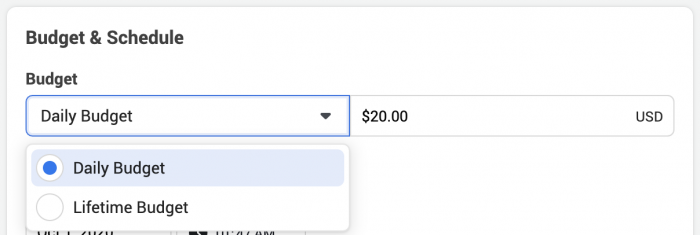
In the example above, Facebook will attempt to spend $20 on a daily basis, regardless of performance.
Let’s say that you have one campaign with three ad sets, and you want to spend $30. You may assign budgets equally like this:
- 1. Ad Set 1: $10
- 2. Ad Set 2: $10
- 3. Ad Set 3: $10
The advertiser determines that distribution, regardless of performance.
When using campaign budget optimization, you would first set a $30 daily budget for the campaign. Facebook will then distribute that budget to provide optimal results — based on the performance of each ad set.
Here’s a visual example, from Facebook:
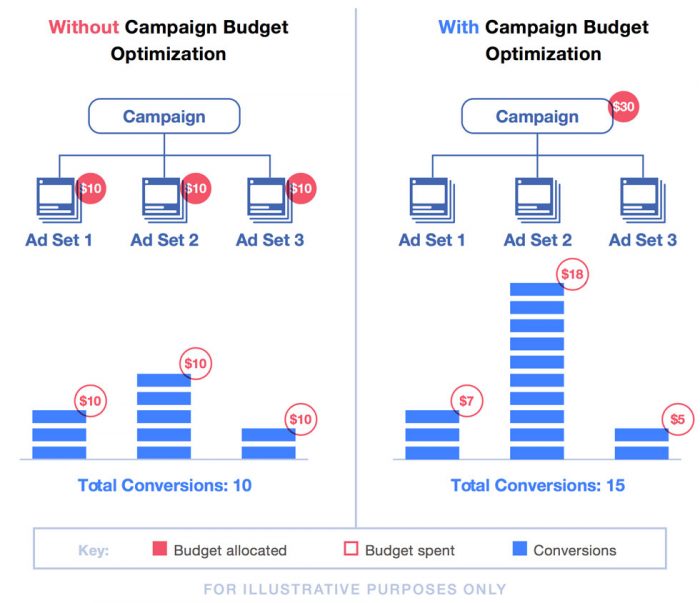
In this example, an advertiser might spend $30 to get 10 conversions without campaign budget optimization. But with it, Facebook can allocate more of the budget to the second, or highest performing, ad set.
Like this:
- 1. Ad Set 1: $7
- 2. Ad Set 2: $18
- 3. Ad Set 3: $5
In that case, the campaign results in 15 conversions.
This process is similar to how Facebook distributes budget between multiple ads within a single ad set. Only this time, we’re dealing with ad sets in a campaign.
Note that this isn’t split testing. Facebook doesn’t find a winner and allocate all of your budget to one ad set. They simply distribute more or less budget based on how an ad set is performing compared to the others.
Along those lines, there can be overlap between ad sets. Don’t expect Facebook to sort that out for you. If you want to avoid overlap, you need to use the split testing feature or apply specific exclusions.
Clearly, this is a feature that is most beneficial when running campaigns with multiple ad sets. It wouldn’t make sense for a single ad set.
Campaign budget optimization is eligible for all objectives.
Campaign Budget Optimization: Campaign Level
When you create a campaign, you’ll have the option of turning on campaign budget optimization (it’s off by default)…

Click the slider button to turn campaign budget optimization on.
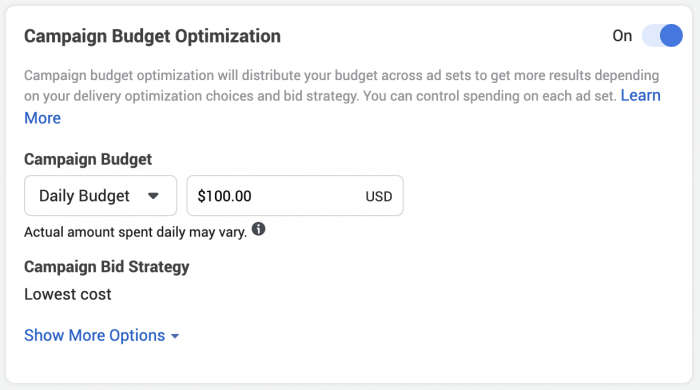
By default, the “Lowest Cost” campaign bid strategy will be selected. But, you can change that if you’d like. Just know that it will apply to all ad sets within this campaign.
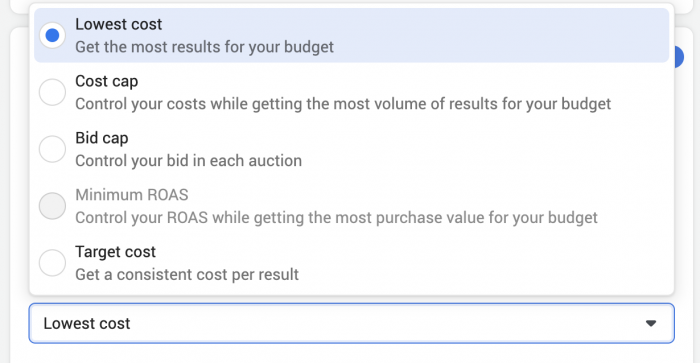
You’ll be able to set a daily or lifetime campaign budget that will be used across ad sets…
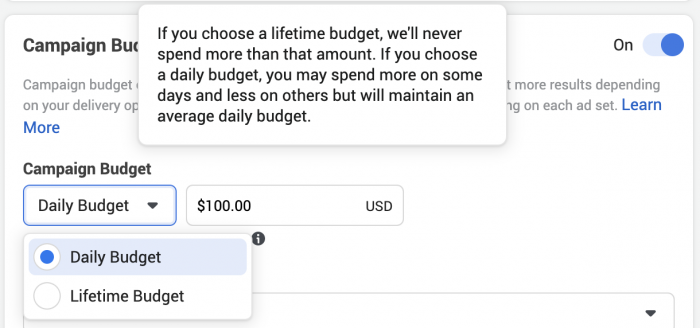
As indicated in the tooltip, a lifetime budget means you’ll never exceed that amount during the lifetime of your campaign.
If you set a daily campaign budget, you may spend more or less than that amount on a daily basis, but it will average out to that daily budget.
Campaign Budget Optimization: Ad Set Level
Since you set the budget at the campaign level when using campaign budget optimization, you no longer need to do so at the ad set level…
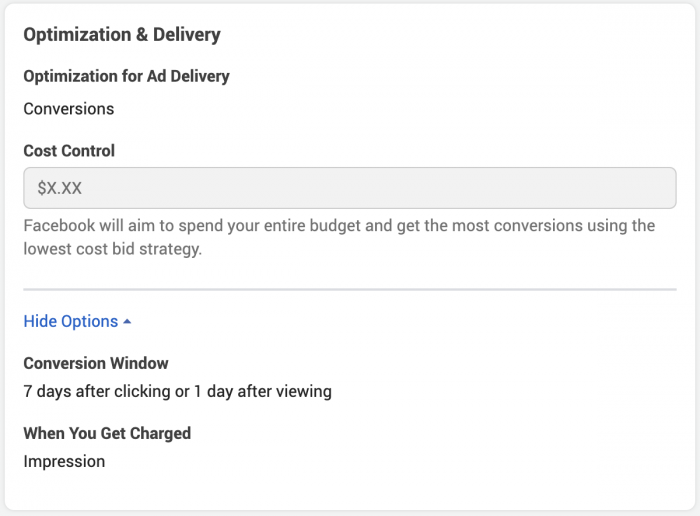
However, maybe you want a little more control over how Facebook distributes your budget. If so, you can set a daily/lifetime minimum or maximum.
Buried within “Budget and Schedule” is an optional Ad Set Spend Limits setting, which is off by default. Click to edit it.
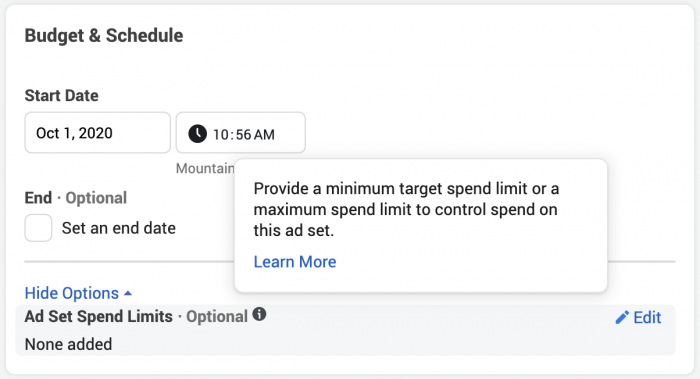
If you assign a minimum, Facebook will do what they can to reach it. However, keep in mind that many factors can prevent that from happening.

Facebook will honor the maximum, however, preventing ad set spend from exceeding an assigned limit on a daily or lifetime basis.

Facebook doesn’t recommend using the maximum since it may prevent you from getting the best possible results. But a minimum could be helpful if you have budget requirements for a particular audience.
Should You Use Campaign Budget Optimization?
Like any feature, I’m not going to give you a universal answer to this. You should try it to see whether it works for you.
That said, Facebook says campaign budget optimization is best under these conditions:
- Set a campaign-level budget and have some flexibility in how that budget is spent across the ad sets in their campaign
- Get the most results possible from their campaign
- Simplify campaign set up and save time by reducing the number of budgets they have to manage manually
Think about your campaigns. Do you create multiple ad sets? Do you have flexibility in how you distribute budget across those ad sets? This may be a good option for you.
Here are a couple of specific ways that I’ve used it…
OPPORTUNITY #1: PROMOTE BLOG POST
Every time I write a blog post, I create a campaign promoting that blog post. Occassionally, I create a campaign with three ad sets for the following audiences:
- Warm Audience (Website Custom Audience, Page Engagement Audience, Email Custom Audience)
- Warm Audience + Interest Expansion
- Interests
I’ll assign a $100 daily budget and allow Facebook to optimize to determine how that budget should be distributed.
OPPORTUNITY #2: PROMOTE QUIZ LIBRARY
I have a quiz library that I promote continuously with lead ads, consisting of multiple ad sets for each audience.
Often I see that Facebook doesn’t distribute the budget the way that I’d expect, sometimes leading to better results in the process.
Should You Use Ad Set Spend Limits?
Personally, I find the use of ad set spend limits to be counterproductive. If you use campaign budget optimization, you are trusting Facebook with distributing your budget optimally across ad sets to get the most results. Setting minimums and maximums could interfere with execution.
If over time you notice issues with campaign budget optimization and budget distribution, you can experiment with setting these. I just wouldn’t recommend it from the start. See how it works over time first.
A Default Option?
Back in 2019, Facebook had planned to make campaign budget optimization the default. In other words, you would not be able to switch this off. Whether in reaction to advertiser revolt or not, Facebook backed off of this stance and CBO remains optional.
Your Turn
Have you experimented with campaign budget optimization? What results are you seeing?
Let me know in the comments below!






